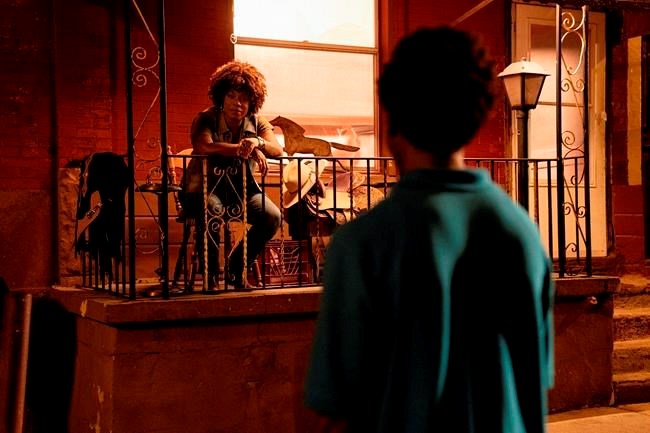NEW YORK ŌĆö Historians estimate that 1 in 4 American cowboys were Black but you would be hard pressed to find a movie genre whiter than the Western. ŌĆ£Concrete Cowboy,ŌĆØ an urban Western about African American riders in Philadelphia starring Idris Elba, is about an often unseen ŌĆö and persisting ŌĆö Black cowboy culture.
ŌĆ£Concrete Cowboy" is a father-son drama set around Fletcher Street Stables, one of the oldest and last-remaining of Philadelphia's hardscrabble inner-city stables. It dates back more than 100 years to when horse-drawn wagons were used to deliver produce, laundry and milk. But through tenacity and improvisation, Fletcher Street has remained a cherished refuge and an ardent pastime for both kids and adults on the streets of PhiladelphiaŌĆÖs Strawberry Mansion.
ŌĆ£ThatŌĆÖs a tough
Neri first heard about the stables in 2008 when a friend sent him a link to a Life magazine article about Fletcher Street.
ŌĆ£The first image I saw was this Black kid on the back of a horse in the middle of the inner city in North Philly,ŌĆØ says Neri. ŌĆ£I had the reaction most people have, which is: ŌĆśWhat is this? WhatŌĆÖs going on here?ŌĆÖŌĆØ
ŌĆ£Concrete Cowboy,ŌĆØ which premiered last fall at the Toronto International Film Festival and debuts Friday on Netflix, shines perhaps the brightest light yet on an abiding community of Black cowboys now facing an uncertain future. It was shot in the vacant lots Fletcher Street cowboys ride in, and its co-stars -- alongside a cast of Elba, Caleb McLaughlin, Method Man and Jharrel Jerome -- include many of the stablesŌĆÖ actual riders.
In a genre thatŌĆÖs been perpetually drawn to American myth and open plains, ŌĆ£Concrete CowboyŌĆØ is urban, contemporary and authentic.
ŌĆ£My dad was a big Western fan. I grew up sort of watching them with a side eye,ŌĆØ says Elba, also a producer. ŌĆ£It didnŌĆÖt occur to me until the Bob Marley song ŌĆśBuffalo Soldier,ŌĆÖ which opened my interest about Black cowboys. And it occurred to me: IŌĆÖve been making films forever and IŌĆÖve never been offered a Western. You realize thereŌĆÖs a deep history that spans America and Africa over decades, centuries in fact, that youŌĆÖve never seen in film.ŌĆØ
As film historian Mia Mask, introducing a series on Black Westerns for the Criterion Channel, has noted: ŌĆ£Hollywood definitely whitewashed the image of the frontier.ŌĆØ The word ŌĆ£cowboy,ŌĆØ itself, was a racist term for a Black ranch worker. (A white one was a cowhand.) John WayneŌĆÖs character in John FordŌĆÖs ŌĆ£The SearchersŌĆØ was based on a Black man.
For the actors, encountering and enmeshing with the community was an eye-opening experience. McLaughlin, the 19-year-old ŌĆ£Stranger ThingsŌĆØ star, plays Cole, a wayward 15-year-old sent by his mother to live with his estranged father, Harp (Elba).
ŌĆ£It was all a new experience,ŌĆØ says McLaughlin. ŌĆ£Being in Philly, there are actually horses that live in peopleŌĆÖs homes there. ItŌĆÖs not just two blocks of people with horses. ItŌĆÖs a whole community. There are people with cowboy boots walking around. There are babies riding ponies. I was like, ŌĆśWow, this is different.ŌĆÖŌĆØ
Staub, making his directorial debut, had initially planned to shoot the entire movie with local non-professional actors.
ŌĆ£Obviously, when Idris Elba shows interest in being in your movie, you pivot,ŌĆØ he says, chuckling. ŌĆ£When I was talking with Idris, it was probably a little brazen, I said, ŌĆśI donŌĆÖt want this to feel like Halloween, like youŌĆÖre playing dress up. To me, you need to do the most work to fit into this world and not vice versa.ŌĆÖŌĆØ
Staub first learned about Fletcher Street while living in Philadelphia. One rider that he befriended, Eric Miller, introduced him around and they began to conceive, a little quixotically, of a movie. Miller, who had once been set to play Harp, was shot and killed just a week before prep began on the film. ŌĆ£Concrete CowboysŌĆØ is dedicated to him. Still, MillerŌĆÖs vision helped guide the production.
ŌĆ£Eric echoed something to me that really had a lot of impact. When he was growing up, he loved cowboy films. These guys even played cowboy videogames on their phones. Everything was about that cowboy life,ŌĆØ says Staub. ŌĆ£But he didnŌĆÖt have a film growing up where cowboys looked like him. What Eric wanted to leave was essentially a Western reimagined with the Black community.ŌĆØ
On set, Staub was flanked by riders looking over his shoulder on the monitor or shouting lines to Elba. ŌĆ£I recognized this was their story to tell,ŌĆØ Staub says.
For Elba, who's also to star in the upcoming revenge Western ŌĆ£The Harder They Fall,ŌĆØ it was more like making a documentary.
ŌĆ£IŌĆÖm very open to telling stories that have a common truth but a unique perspective,ŌĆØ Elba says. ŌĆ£People in London, in Hackney where I grew up, will watch ŌĆśConcrete CowboyŌĆÖ thinking it might be a Western and go, ŌĆśOh man.ŌĆÖŌĆØ
The Fletcher Street Stables are also imperiled. The vacant lot its riders had long used -- and which theyŌĆÖre seen riding through frequently in the film -- is currently being developed. To survive, Fletcher Street needs a more permanent home. To facilitate that, the filmmakers have helped organize a
ŌĆ£WeŌĆÖve been losing these stables one by one to gentrification. Fletcher Street is one of the first and last. ItŌĆÖs kind of like our history is being erased,ŌĆØ says Erin Brown, director of the Philadelphia Urban Riding Academy.
Brown, who served as a consultant, extra and stunt rider on the film, first started riding as a 6-year-old. She vividly remembers, as a kid, watching the cowboys riding down the street from her great-auntŌĆÖs porch. Since then, Fletcher Street has been her home.
ŌĆ£You come to the stables and you feel this love,ŌĆØ says Brown. ŌĆ£It builds you as a person.ŌĆØ
___
Follow AP Film Writer Jake Coyle on Twitter at: http://twitter.com/jakecoyleAP
Jake Coyle, The Associated Press




